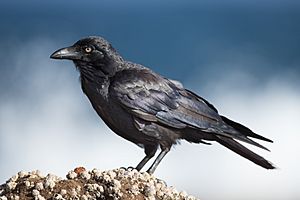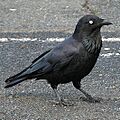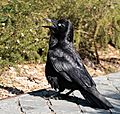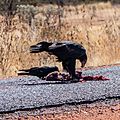Australian raven facts for kids
Quick facts for kids Australian raven |
|
|---|---|
 |
|
| Conservation status | |
| Scientific classification | |
| Genus: |
Corvus
|
| Species: |
coronoides
|
| Subspecies | |
|
|
 |
|
| Synonyms | |
|
Corvus affinis Brehm, 1845 |
|
The Australian raven (Corvus coronoides) is a type of passerine bird found across much of southern and northeastern Australia. It's known for its all-black look, from its feathers to its beak and mouth. This bird measures about 46 to 53 centimeters (18 to 21 inches) long.
Its feathers are glossy, with hints of purple, blue, or green. The Australian raven has strong grey-black legs and feet. You can tell it apart from other Australian crows by the special throat feathers, called hackles, which are very noticeable on adult birds. Young ravens have dark brown eyes, which gradually turn white as they get older.
Scientists Nicholas Aylward Vigors and Thomas Horsfield first described the Australian raven in 1827. Its scientific name, coronoides, means "crow-shaped". There are two recognized subspecies, which are slightly different in their calls and genetics.
These ravens prefer open woodlands and areas where different habitats meet. They have also become very good at living in cities. You can often spot them in places like Sydney, Canberra, and Perth. Australian ravens eat many different things, including plants, animals, and even food scraps from cities. They are very smart and adaptable birds.
Contents
What is an Australian Raven?
The Australian raven is the biggest type of crow or raven in Australia. It can grow up to 53 cm (21 inches) long. Its wingspan can reach about 100 cm (39 inches). An adult raven usually weighs around 650 grams (1.4 pounds).
How to Spot an Australian Raven
This bird is completely black, including its beak, mouth, and tongue. Its legs and feet are sturdy and grey-black. A key feature is its white irises. This is how you can often tell it's an adult.
You can also tell Australian ravens apart from crows by looking at the base of their feathers. Ravens have grey feather bases, while crows have white ones. This is hard to see unless the wind ruffles their feathers.
Eye Color Changes
The eye color of a raven changes as it grows up.
- Young birds (up to 4 months old) have blue-grey eyes.
- Juveniles (4 to 15 months old) have dark brown eyes.
- Immature birds (up to 2 years and 10 months old) have hazel eyes with a blue ring around the pupil.
- Adults have completely white irises.
Young Ravens
Young ravens look similar to adults but don't have the long throat hackles. Their beaks are shorter and sometimes pinkish at the base. Their feathers look softer and can have a brownish tint.
What Sounds Do They Make?
The Australian raven has a special call to mark its territory. It's a slow, high ah-ah-aaaah, with the last note stretched out. When they make this call, they stand horizontally, holding their head forward. They also ruffle their throat feathers.
This call helps them communicate with other ravens. If another bird enters their area, the call gets louder. Each of the five Australian raven and crow species has a slightly different call. This makes their calls the easiest way to tell them apart.
Ravens also have other calls for different situations.
- They make soft murmuring sounds when they are preening each other.
- Flocks make quiet chattering sounds when resting.
- They use a "call and answer" sequence if they can't see each other while looking for food.
- A single high-pitched caa means they are just flying through another bird's territory.
Where Do Australian Ravens Live?
Australian ravens are common in eastern and southern Western Australia. They are less common in the north. They need water and trees (or buildings) to rest in.
They like forests, especially those with eucalypt trees. They also live in farmlands next to trees. These birds have adapted very well to living near people. They are the most common raven or crow in cities like Canberra, Sydney, and Perth.
Because they are found in many places and their numbers are growing, they are listed as a species of "Least Concern". This means they are not currently at risk of disappearing.
How Do Australian Ravens Behave?
Australian ravens usually stay in one place. Young birds leave their parents when they are about four or five months old. They join flocks with other young ravens. Smaller groups of 8–30 birds stay in an area of about 260 square kilometers (100 square miles). Larger flocks of up to 300 birds might travel long distances to find food.
A pair of breeding ravens and their young will stay in their territory all year. They defend their territory from other birds, foxes, and sometimes even people. They usually mate for life. If one bird dies, the other will find a new mate.
Ravens often walk on the ground, but they can hop if they need to hurry. They spend a lot of time cleaning their feathers. They also preen each other's heads and necks. This helps them bond as a pair.
Breeding and Nests
Australian ravens start breeding when they are three years old. The breeding season is usually from July to September. They build their nests in tall trees, high off the ground. Sometimes, they build nests on buildings or tall windmills.
Their nests are usually large and messy. They are made of sticks and lined with grass, bark, and feathers. The nests are quite heavy, so they are built on strong branches. Both parents help build the nest. The female lines the nest, while the male brings materials.
They usually build a new nest each year. Old nests can break apart or spread diseases. A female raven lays about four or five eggs, but sometimes up to six. The eggs are pale green or bluish-green with darker spots. The female sits on the eggs for about 20 days until they hatch. They usually raise only one group of young each year.
What Do Australian Ravens Eat?
Australian ravens eat a wide variety of foods. They eat more meat than smaller crows. In summer, they eat many insects. In autumn, they eat more plants. In winter, meat makes up more than half of their diet.
They commonly eat spiders, millipedes, grasshoppers, and caterpillars. They also eat yabbies (a type of freshwater crayfish). Ravens often eat dead animals, as many animals are too big for them to kill. However, they do hunt young rabbits.
Ravens drink water often, especially when it's hot. They have been seen dipping pieces of meat or hard biscuits in water to make them softer.
Australian ravens are very smart when it comes to finding food. They look for food in the early morning or late afternoon. They mostly find food on the ground, either by flying over or walking along. They also look for nests and eggs in trees. Sometimes, they even take golf balls, perhaps mistaking them for eggs!
They have adapted well to eating food scraps in cities. You might see them near school playgrounds, rubbish tips, or outside restaurants.
Who Hunts Australian Ravens?
The wedge-tailed eagle hunts adult and young Australian ravens. The little eagle also preys on young ravens. Powerful owls have been known to kill adult ravens.
The introduced red fox also competes with ravens for food like dead animals. Foxes might also kill young birds they catch on the ground.
Ravens and People
Australian ravens are generally peaceful birds. They don't usually act aggressively towards people or other birds without a good reason.
Sometimes, farmers blame ravens for killing young lambs. However, studies show this is very rare. Ravens are much more likely to eat afterbirth or lambs that were already stillborn.
In Aboriginal Culture
In Australian Aboriginal mythology, the Crow is a very important figure. Crow is often seen as a trickster and a culture hero. In some Aboriginal groups, like the Kulin nation in Victoria, Crow was known as Waa. He was one of two main ancestors, along with the eaglehawk. Stories about Crow are found in many different Aboriginal cultures across Australia.
To the Noongar people of southwestern Australia, the Australian raven was called Waardar, meaning "the Watcher". They saw it as clever and unpredictable.
Images for kids
-
Adult in Sydney. Shows bare skin on neck
-
Juvenile with dark irises, Hyde Park, Sydney.
-
Adult with all-white irises, University of Sydney.
-
Australian raven scavenging roadkill with a wedge-tailed eagle
See also
 In Spanish: Cuervo australiano para niños
In Spanish: Cuervo australiano para niños









